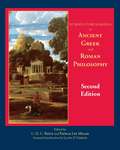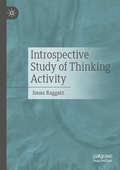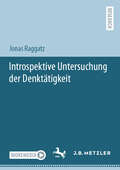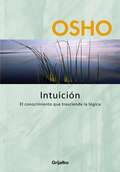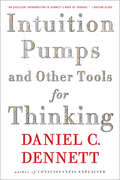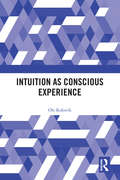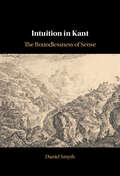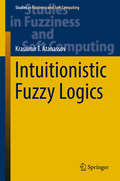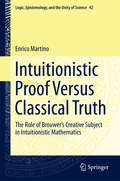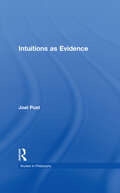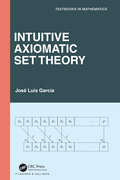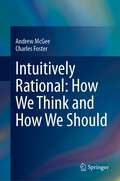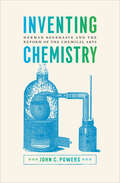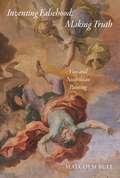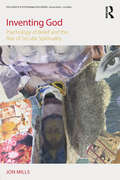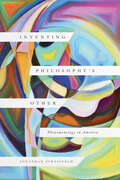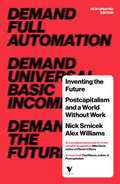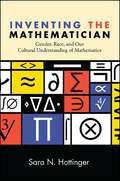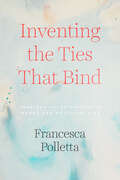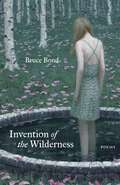- Table View
- List View
Introductory Readings in Ancient Greek and Roman Philosophy
by Lloyd P. Gerson C. D. Reeve Patrick Lee MillerA concise anthology for the ancient philosophy survey that ranges from the Presocratics through the Neoplatonists, Introductory Readings in Ancient Greek and Roman Philosophy features essential selections from C.D.C. Reeve's 2004 translation of Plato's Republic, which casts reported speech into direct dialogue, as well other translations known for their accuracy and accessibility. Introductions and notes are also included.
Introductory Readings in the Philosophy of Science
by E. D. Klemke Robert Hollinger David W. Rudge A. David KlineFor nearly two decades, "Introductory Readings in the Philosophy of Science" has distinguished itself as the standard for texts specifically designed to meet the needs of beginning students. Retaining the best essays from the first two editions, the editors have added ten important new selections to maintain this influential text's relevance for today and tomorrow. Readings cover such timely and important topics as feminism and the sciences, the effects of science on society, the natural versus the social sciences, and science and human values.
Introspective Study of Thinking Activity
by Jonas RaggatzThis book explores whether there exists a distinct form of cognitive phenomenality that cannot be reduced to sensory experience. To investigate this central question in the cognitive phenomenology debate from an introspective-empirical perspective, the method of introspection is examined—along with its challenges and criticisms—through an evaluation of both historical and contemporary approaches to introspective research. In addition, a qualitative-empirical study of thinking activity is conducted to uncover performative and agentive phenomena, which may serve as arguments for a cognitively phenomenal dimension irreducible to sensory or emotional experience.
Introspektive Untersuchung der Denktätigkeit
by Jonas RaggatzIn diesem Buch wird untersucht, ob es eine eigenständige kognitive Phänomenalität gibt, die nicht auf sinnliche Erfahrungen reduziert werden kann. Um diese zentrale Frage der Kognitiven-Phänomenologie-Debatte introspektiv-empirisch untersuchen zu können, wird einerseits die Methode der Introspektion mit ihren Kritikpunkten und Problemen behandelt, indem historische und zeitgenössische Ansätze introspektiver Forschung sowie deren Kritik dargestellt und evaluiert werden. Andererseits wird eine qualitativ-empirische Studie zur Denktätigkeit durchgeführt, um performativ-agentive Phänomene aufzuzeigen, die als Argumente für eine sensorisch und emotional irreduzible kognitive Phänomenalität interpretiert werden können.
Intuición
by Osho OshoLa intuición es la percepción directa de la realidad sin que haya ninguna interferencia de los prejuicios y la ideología de la mente. Es un «conocimiento que trasciende la lógica»; solo aquellos que son capaces de trascender las limitaciones de la lógica y el análisis son también capaces de responder creativamente a las situaciones nuevas y cambiantes que encuentran cada día. En este libro, Osho muestra el camino para eliminar los obstáculos que han sido colocados en el recorrido de nuestra intuición, de modo que esta pueda florecer y proporcionar así un nuevo tipo de inteligencia y plenitud a nuestras vidas.
Intuition Pumps And Other Tools for Thinking
by Daniel C. Dennett"The best new book I've read."--Richard Dawkins, New York Times Book Review Over a storied career, Daniel C. Dennett has engaged questions about science and the workings of the mind. His answers have combined rigorous argument with strong empirical grounding. And a lot of fun. Intuition Pumps and Other Tools for Thinking offers seventy-seven of Dennett's most successful "imagination-extenders and focus-holders" meant to guide you through some of life's most treacherous subject matter: evolution, meaning, mind, and free will. With patience and wit, Dennett deftly deploys his thinking tools to gain traction on these thorny issues while offering readers insight into how and why each tool was built. Alongside well-known favorites like Occam's Razor and reductio ad absurdum lie thrilling descriptions of Dennett's own creations: Trapped in the Robot Control Room, Beware of the Prime Mammal, and The Wandering Two-Bitser. Ranging across disciplines as diverse as psychology, biology, computer science, and physics, Dennett's tools embrace in equal measure light-heartedness and accessibility as they welcome uninitiated and seasoned readers alike. As always, his goal remains to teach you how to "think reliably and even gracefully about really hard questions." A sweeping work of intellectual seriousness that's also studded with impish delights, Intuition Pumps offers intrepid thinkers--in all walks of life--delicious opportunities to explore their pet ideas with new powers.
Intuition as Conscious Experience
by Ole KoksvikIs torturing the innocent OK? Just now something happened: it seemed to you that torturing the innocent is wrong. What kind of mental state were you in? What is its nature? Perhaps you now believe that torturing the innocent is wrong because it just seemed to you that it is. If so, that seems appropriate. But is it really, and if so, what could explain this? In this book, Koksvik argues these mental states form a psychological kind called ‘intuition’, and that having an intuition indeed justifies you in believing what it says. What explains this, he argues, is how similar intuition is to perception. Through a detailed examination he shows that intuition, just like perception, is a conscious experience, and that the two experience types have important properties in common, in virtue of which they can both justify belief. In sharp contrast to traditional thought, Koksvik argues that intuition is completely unrestricted in content: we have intuitions about morality and metaphysics, but also about all sorts of everyday things, like danger or trustworthiness, and in all cases they can justify. The use of intuition is thus not only a legitimate part of philosophical and scientific practice, it also plays a pervasive, important and legitimate role in all of our everyday rational lives.
Intuition in Kant: The Boundlessness of Sense
by Daniel SmythIn this book Daniel Smyth offers a comprehensive overview of Immanuel Kant's conception of intuition in all its species – divine, receptive, sensible, and human. Kant considers sense perception a paradigm of intuition, yet claims that we can represent infinities in intuition, despite the finitude of sense perception. Smyth examines this heterodox combination of commitments and argues that the various features Kant ascribes to intuition are meant to remedy specific cognitive shortcomings that arise from the discursivity of our intellect Intuition acting as the intellect's cognitive partner to make knowledge possible. He reconstructs Kant's conception of intuition and its role in his philosophy of mind, epistemology, and philosophy of mathematics, and shows that Kant's conception of sensibility is as innovative and revolutionary as his much-debated theory of the understanding.
Intuitionistic Fuzzy Logics
by Krassimir T. AtanassovThe book offers a comprehensive survey of intuitionistic fuzzy logics. By reporting on both the author's research and others' findings, it provides readers with a complete overview of the field and highlights key issues and open problems, thus suggesting new research directions. Starting with an introduction to the basic elements of intuitionistic fuzzy propositional calculus, it then provides a guide to the use of intuitionistic fuzzy operators and quantifiers, and lastly presents state-of-the-art applications of intuitionistic fuzzy sets. The book is a valuable reference resource for graduate students and researchers alike.
Intuitionistic Proof Versus Classical Truth: The Role Of Brouwer's Creative Subject In Intuitionistic Mathematics (Logic, Epistemology, and the Unity of Science #42)
by Enrico MartinoThis book examines the role of acts of choice in classical and intuitionistic mathematics. Featuring fifteen papers – both new and previously published – it offers a fresh analysis of concepts developed by the mathematician and philosopher L.E.J. Brouwer, the founder of intuitionism.The author explores Brouwer’s idealization of the creative subject as the basis for intuitionistic truth, and in the process he also discusses an important, related question: to what extent does the intuitionistic perspective succeed in avoiding the classical realistic notion of truth? The papers detail realistic aspects in the idealization of the creative subject and investigate the hidden role of choice even in classical logic and mathematics, covering such topics as bar theorem, type theory, inductive evidence, Beth models, fallible models, and more. In addition, the author offers a critical analysis of the response of key mathematicians and philosophers to Brouwer’s work. These figures include Michael Dummett, Saul Kripke, Per Martin-Löf, and Arend Heyting.This book appeals to researchers and graduate students with an interest in philosophy of mathematics, linguistics, and mathematics.
Intuitions as Evidence
by Joel PustFirst published in 2000. Routledge is an imprint of Taylor & Francis, an informa company.
Intuitions as Evidence (Studies In Philosophy Ser.)
by Joel PustFirst published in 2000. Starting with Kripke's quotation on intuitive content being philosophic evidence, in this essay, the author aims to demonstrate how contemporary philosophy relies on intuitions as evidence, to explain what intuitions are and show why certain contemporary arguments against the use of intuitions as evidence fail.
Intuitive Axiomatic Set Theory (Textbooks in Mathematics)
by José L GarciáSet theory can be rigorously and profitably studied through an intuitive approach, thus independently of formal logic. Nearly every branch of Mathematics depends upon set theory, and thus, knowledge of set theory is of interest to every mathematician. This book is addressed to all mathematicians and tries to convince them that this intuitive approach to axiomatic set theory is not only possible but also valuable.The book has two parts. The first one presents, from the sole intuition of "collection" and "object", the axiomatic ZFC-theory. Then, we present the basics of the theory: the axioms, well-orderings, ordinals and cardinals are the main subjects of this part. In all, one could say that we give some standard interpretation of set theory, but this standard interpretation results in a multiplicity of universes. The second part of the book deals with the independence proofs of the continuum hypothesis (CH) and the axiom of choice (AC), and forcing is introduced as a necessary tool, and again the theory is developed intuitively, without the use of formal logic. The independence results belong to the metatheory, as they refer to things that cannot be proved, but the greater part of the arguments leading to the independence results, including forcing, are purely set-theoretic. The book is self-contained and accessible to beginners in set theory. There are no prerequisites other than some knowledge of elementary mathematics. Full detailed proofs are given for all the results.
Intuitively Rational: How We Think and How We Should
by Charles Foster Andrew McGeeThis book is about the respective roles of intuition and reasoning in ethics. It responds to a number of well-known philosophers and psychologists, and proposes a new perspective – radical in its moderation. It examines in depth the work of the philosopher Joshua Greene and the psychologist Jonathan Haidt. With the so-called empirical turn in ethics, much work has been done to try to isolate the role of reason and intuition in forming our moral judgements, with Haidt and Greene leading the research programmes and attracting much of the professional and public attention, and many others following. The current view – shared by both camps – is that intuition is largely the driver of our moral judgements – a view summed up in Haidt’s slogan ‘intuition first, strategic reasoning second’. Haidt believes we have to live with this and accept it. Greene does not: he contends that our intuitions, while suitable for the environments in which we evolved, are worthless in the modern, global, technological age, and to avoid ethical disaster we must learn to adopt reason as the arbiter of moral truth. This book steers a middle course between these two positions and is therefore of great interest to philosophers and psychologists alike.
Inventing Arguments (Second Edition)
by John Mauk John MetzThe text's prominent focus on invention teaches students to recognize the rhetorical elements of any argumentative situation and apply the tools of argument effectively in their own writing.
Inventing Arguments: Brief 4th Edition
by John Mauk John MetzOrganized around common rhetorical situations that occur all around us, INVENTING ARGUMENTS shows you that argument is a living process rather than a form to be modeled. Through the text's prominent focus on invention, you will learn to recognize the rhetorical elements of any argumentative situation and apply the tools of argument effectively in your own writing. The basic layers of argument are introduced in early chapters, with material arranged into increasingly sophisticated topics beginning with the most obvious or explicit layers (claims) and moving to more implied or "hidden" layers (assumptions, values, beliefs, ideology). By the time you finish Part 1, you will have a thorough understanding of argument, which you can then apply not just to the invention projects but also to your writing for other college courses and beyond.
Inventing Chemistry: Herman Boerhaave and the Reform of the Chemical Arts (Synthesis)
by John C. PowersThe story of this little-known Dutch physician &“will interest students and practitioners of history, chemistry, and philosophy of science&” (Choice). In Inventing Chemistry, historian John C. Powers turns his attention to Herman Boerhaave (1668–1738), a Dutch medical and chemical professor whose work reached a wide, educated audience and became the template for chemical knowledge in the eighteenth century. The primary focus of this study is Boerhaave&’s educational philosophy, and Powers traces its development from Boerhaave&’s early days as a student in Leiden through his publication of the Elementa chemiae in 1732. Powers reveals how Boerhaave restructured and reinterpreted various practices from diverse chemical traditions (including craft chemistry, Paracelsian medical chemistry, and alchemy), shaping them into a chemical course that conformed to the pedagogical and philosophical norms of Leiden University&’s medical faculty. In doing so, Boerhaave gave his chemistry a coherent organizational structure and philosophical foundation, and thus transformed an artisanal practice into an academic discipline. Inventing Chemistry is essential reading for historians of chemistry, medicine, and academic life.
Inventing Falsehood, Making Truth: Vico and Neapolitan Painting (Essays in the Arts)
by Malcolm BullHow the philosophy of Giambattista Vico was influenced by eighteenth-century Neopolitan paintingCan painting transform philosophy? In Inventing Falsehood, Making Truth, Malcolm Bull looks at Neapolitan art around 1700 through the eyes of the philosopher Giambattista Vico. Surrounded by extravagant examples of late Baroque painting by artists like Luca Giordano and Francesco Solimena, Vico concluded that human truth was a product of the imagination. Truth was not something that could be observed: instead, it was something made in the way that paintings were made--through the exercise of fantasy.Juxtaposing paintings and texts, Bull presents the masterpieces of late Baroque painting in early eighteenth-century Naples from an entirely new perspective. Revealing the close connections between the arguments of the philosophers and the arguments of the painters, he shows how Vico drew on both in his influential philosophy of history, The New Science. Bull suggests that painting can serve not just as an illustration for philosophical arguments, but also as the model for them--that painting itself has sometimes been a form of epistemological experiment, and that, perhaps surprisingly, the Neapolitan Baroque may have been one of the routes through which modern consciousness was formed.
Inventing God: Psychology of Belief and the Rise of Secular Spirituality (Philosophy and Psychoanalysis)
by Jon MillsIn this controversial book, philosopher and psychoanalyst Jon Mills argues that God does not exist; and more provocatively, that God cannot exist as anything but an idea. Put concisely, God is a psychological creation signifying ultimate ideality. Mills argues that the idea or conception of God is the manifestation of humanity’s denial and response to natural deprivation; a self-relation to an internalized idealized object, the idealization of imagined value. After demonstrating the lack of any empirical evidence and the logical impossibility of God, Mills explains the psychological motivations underlying humanity’s need to invent a supreme being. In a highly nuanced analysis of unconscious processes informing the psychology of belief and institutionalized social ideology, he concludes that belief in God is the failure to accept our impending death and mourn natural absence for the delusion of divine presence. As an alternative to theistic faith, he offers a secular spirituality that emphasizes the quality of lived experience, the primacy of feeling and value inquiry, ethical self-consciousness, aesthetic and ecological sensibility, and authentic relationality toward self, other, and world as the pursuit of a beautiful soul in search of the numinous. Inventing God will be of interest to academics, scholars, lay audiences and students of religious studies, the humanities, philosophy, and psychoanalysis, among other disciplines. It will also appeal to psychotherapists, psychoanalysts and mental health professionals focusing on the integration of humanities and psychoanalysis.
Inventing Philosophy's Other: Phenomenology in America
by Jonathan StrassfeldThe history of phenomenology, and its absence, in American philosophy. Phenomenology and so-called “continental philosophy” receive scant attention in most American philosophy departments, despite their foundational influence on intellectual movements such as existentialism, post-structuralism, and deconstruction. In Inventing Philosophy’s Other, Jonathan Strassfeld explores this absence, revealing how everyday institutional practices played a determinative role in the development of twentieth-century academic discourse. Conventional wisdom holds that phenomenology’s absence from the philosophical mainstream in the United States reflects its obscurity or even irrelevance to America’s philosophical traditions. Strassfeld refutes this story as he traces phenomenology’s reception in America, delivering the first systematic historical study of the movement in the United States. He examines the lives and works of Marjorie Grene, Alfred Schütz, Hubert Dreyfus, and Iris Marion Young, among others, while also providing a fresh introduction to phenomenological philosophy.
Inventing the Future
by Alex Williams Nick SrnicekA major new manifesto for a high-tech future free from workNeoliberalism isn't working. Austerity is forcing millions into poverty and many more into precarious work, while the left remains trapped in stagnant political practices that offer no respite. Inventing the Future is a bold new manifest0 for life after capitalism. Against the confused understanding of our high-tech world by both the right and the left, this book claims that the emancipatory and future-oriented possibilities of our society can be reclaimed. Instead of running from a complex future, Nick Srnicek and Alex Williams demand a postcapitaiist economy capable of advancing standards, liberating humanity from work and developing technologies that expand our freedoms.
Inventing the Individual: The Origins of Western Liberalism
by Larry SiedentopHere, in a grand narrative spanning 1,800 years of European history, a distinguished political philosopher firmly rejects Western liberalism's usual account of itself: its emergence in opposition to religion in the early modern era. Larry Siedentop argues instead that liberal thought is, in its underlying assumptions, the offspring of the Church.
Inventing the Mathematician: Gender, Race, and Our Cultural Understanding of Mathematics
by Sara N. HottingerWhere and how do we, as a culture, get our ideas about mathematics and about who can engage with mathematical knowledge? Sara N. Hottinger uses a cultural studies approach to address how our ideas about mathematics shape our individual and cultural relationship to the field. She considers four locations in which representations of mathematics contribute to our cultural understanding of mathematics: mathematics textbooks, the history of mathematics, portraits of mathematicians, and the field of ethnomathematics. Hottinger examines how these discourses shape mathematical subjectivity by limiting the way some groups—including women and people of color—are able to see themselves as practitioners of math. Inventing the Mathematician provides a blueprint for how to engage in a deconstructive project, revealing the limited and problematic nature of the normative construction of mathematical subjectivity.
Inventing the Ties That Bind: Imagined Relationships in Moral and Political Life
by Francesca PollettaFrom deciding to hold the door for the person behind you, to resolving for whom you will cast your vote, every day we find ourselves charged with making moral decisions. What steers our choices? And how do we weigh competing priorities and moral convictions? In Inventing the Ties That Bind, Francesca Polletta shows that we do not solve these dilemmas, whether personal or political, based on self-interest alone. Instead, relationships serve as a kind of moral compass. People consider the nature of their ties to one another to know what their obligations are, and in situations that are unfamiliar, they sometimes figure out the right thing to do by imagining themselves in relationships they do not actually have. Polletta takes up a wide range of cases, from debt settlement agencies to the southern civil rights movement, revealing that our relationships and how we imagine them are at the heart of our moral lives—guiding us as we choose whom to help and how we define what it means to treat someone as our equal. In a time of growing polarization, understanding how we make sense of our ties to one another is more urgent than ever.
Invention of the Wilderness: Poems
by Bruce BondIn Invention of the Wilderness, Bruce Bond explores the wilderness as a spiritual, psychological, and ecological realm—a territory that, depending on our tolerances and affections, calls out for order, exploitation, expansion, or preservation. Although to talk of “inventing” the wilderness seems paradoxical, the book seeks to reclaim the etymological root of “invention” as a “venturing in.” To invent a wilderness is to go inward by way of attentive engagement in the natural world, to affirm and liberate imaginative expression as no mere mirror of nature, but a force of it. At times meditative and melancholic, though also vibrant and full of life, Invention of the Wilderness proposes an embodied and reflective way of being in the world.
